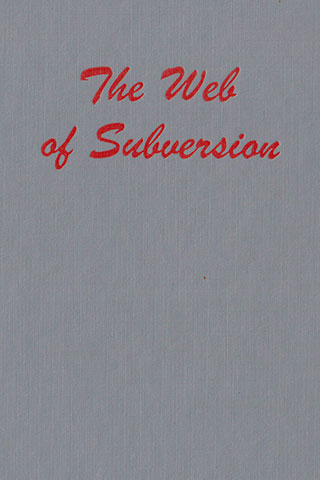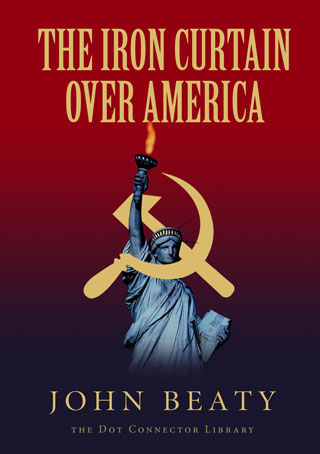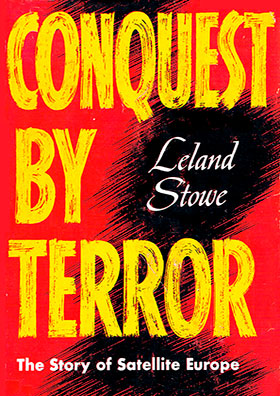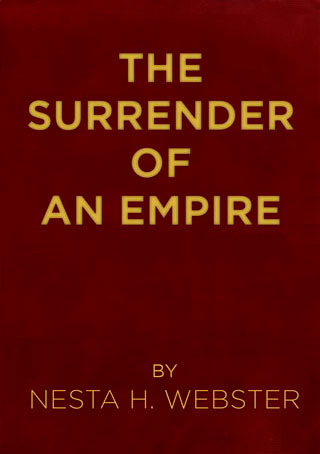Sleeper Apparatus
Underground Networks in the U.S. Government
(New York: John Day Co., Jan 1954) 10,472 views
June 2, 2019

It is very hard to detect a well-run conspiracy. It is hard for common sense to grasp the reality of an “underground,” which seems to fit more naturally into fiction or movies rather than fact. It is harder still to assemble legally acceptable proof concerning its members and activities.
The Communist conspiracy, although larger, more absolute and more successful than any other, is not the only underground, of course. Various kinds of conspiracy—of secret, clandestine, underground association—have always existed in business, ordinary politics, and crime. Espionage, subversion, sabotage and terror are in general assigned to underground organizations. The Communists, although pre-eminent, are not alone in their addiction to such pursuits.
Over the years, the lessons of experience have become incorporated in certain working rules for conspiratorial, “underground” operations. The purpose of most of these is to preserve secrecy, which is of the essence of the underground. The rules aim to prevent detection, and at the same time to guarantee that the whole structure will not be endangered if one member or one action does nevertheless get detected. The Communists, while adding new technical discoveries of their own, do not neglect the traditional rules.
In understanding the Communist underground, three of the rules are of particular importance.
 (1) Decentralization. The ultimate control (“command”) of the entire international underground is centralized in the Soviet headquarters. Operationally, however, the underground is broken up into a maze of comparatively small groups. Each of these is relatively independent. Ordinarily an operating unit has only a single link with the higher apparatus, and this is not direct but through one or more “cutouts.” A courier such as Elizabeth Bentley or Whittaker Chambers links an active cell to a more direct agent of the Soviet apparatus, such as Anatol Gromov or Jacob Golos. He is probably using a diplomatic, commercial or journalistic job as “cover,” and is in turn linked to a higher level cell.
(1) Decentralization. The ultimate control (“command”) of the entire international underground is centralized in the Soviet headquarters. Operationally, however, the underground is broken up into a maze of comparatively small groups. Each of these is relatively independent. Ordinarily an operating unit has only a single link with the higher apparatus, and this is not direct but through one or more “cutouts.” A courier such as Elizabeth Bentley or Whittaker Chambers links an active cell to a more direct agent of the Soviet apparatus, such as Anatol Gromov or Jacob Golos. He is probably using a diplomatic, commercial or journalistic job as “cover,” and is in turn linked to a higher level cell.
In addition, there is sometimes a horizontal link, through a single individual, with another group or cell on the same level. The Bentley testimony suggests that Irving Kaplan linked the Silvermaster and Perlo cells horizontally.
The rule of decentralization means that so long as the center survives it is never possible to uncover much of the total network at once. Apart from a blow at the center, no single stroke can do the underground more than minor damage. The detection and destruction of the underground are necessarily a slow, wearisome job.
(2) No records. A well-run conspiracy tries to keep its records, even at the center, to a minimum. The rule for activists—field agents—is that there should be no records or documents whatever: literally none.
For persons fortunate enough to have had no experience of underground life this rule is difficult to grasp. Lawyers, detectives and judges are puzzled and troubled by the lack of “material proof.” Even Congressmen with some years of service on the investigating committees keep asking about “Party cards,” membership lists, receipts, copies of documents allegedly transmitted, and so on.
But generally speaking, when correct technique is faithfully followed, there are no documents and no other “material” evidence of any kind. In testifying on these points before the Internal Security Subcommittee, Whittaker Chambers observed: “So far as I know, no one signs any recruitment blanks.” [1] Mr. J. G. Sourwine, of Committee counsel, asked:
Miss Bentley, while you were such an underground agent, was there in existence documentary evidence of the fact that you were such an agent?
Miss Bentley. No, except possibly in Moscow.
Mr. Sourwine. Did you feel that it was your business to make sure that there was no such documentary evidence?
Miss Bentley. Definitely. I took every possible precaution.
Mr. Sourwine. Can you expand at all on the subject of whether there would be any likelihood of being able to get documentary evidence of the fact that an active underground agent is in fact such an agent?
Miss Bentley. You mean documentary evidence in the form of written evidence? I doubt it. … There were no credentials.
Hede Massing, for many years a professional agent of the Soviet apparatus, stated:
You could never prove, for example, that I was a Party member. And I was a Party member. And if I had been asked when I was a Communist if I was a Party member, I would have said, “No; I wasn’t.”
Herbert Philbrick was for many years simultaneously an agent in two undergrounds—that of the FBI and, under FBI direction, that of the Communists. He testified that he could not have proved himself either the one or the other by any documents.
Mr. Sourwine. Mr. Philbrick, while you were operating as an underground agent was there in existence, so far as you know, documentary evidence of that fact?
Mr. Philbrick. I don’t believe there was any at all, sir. Of course, I operated in a dual capacity. … So far as the Communist Party was concerned, in 1947, when I was ordered by the Party to go into the real underground section of the Party, I was also at the same time ordered to destroy any and all documentary evidence. I was ordered, for example, to destroy a Party card if I held one and never to carry one again. …
The very words that were used were, “You are to drop out of the Party.”
And yet I was becoming more of a Party member than I had ever been before.
But what it means is that the Russian bosses and the Communist Party realize that they have not only an underground organization but an illegal operation, and therefore they use this, it seems to me, to make it impossible or try to make it impossible to legally prove that any of these people are Party members. They all carry no cards and they operate as though they are not legally Party members, when actually of course they are.
Admiral Roscoe Hillenkoetter, the first Director of the Central Intelligence Agency, confirmed this “no record” rule of underground work.
Mr. Sourwine. Sir, from what you can speak of your knowledge of underground activities, what can you tell us of the likelihood that an active undercover agent could be proven to be such by documentary evidence?
Mr. Hillenkoetter. Well, the only way you could ever prove he was an agent by documentary evidence is that he would be very stupid. He would certainly not be worthwhile having if he had any documentary evidence. The first thing would be to do away with all documentary evidence. …
Mr. Sourwine. Perhaps you can tell the Committee … whether the CIA does or does not take care to avoid the very existence of documentary evidence with regard to underground agents and their identities.
Mr. Hillenkoetter. I can’t answer for that now, I am no longer there. But they certainly did when I was there.
When he retained some papers and films—part of which eventually emerged from the pumpkin—Whittaker Chambers was deliberately, and at grave personal risk, violating this primary rule. “In the normal course of events,” Miss Bentley has explained, “everything that I took in was automatically handed over to the Soviet superior within a matter of 24 to 48 hours. Nothing was left behind.”
Mr. Morris. Did you yourself make copies to keep on file?
Miss Bentley. No, sir. … And they were so fussy about this whole matter that when they sent me a typewritten sheet of instructions I had to read it and burn it in front of the person who gave it to me, because they didn’t want me found with that in my handbag in case I got careless.
As a matter of fact, it is a violation of the most approved procedure even to have a written copy of instructions in existence in the first place.
Mr. Sourwine. In normal course, would you say it was possible for a CIA agent to take instructions over a period of months from a superior who was actually his superior and yet be unable to show or to testify that he ever saw any evidence that the man was, in fact, an employee and his superior?
Admiral Hillenkoetter. It would be very easy; yes, sir.
Mr. Sourwine. As a matter of fact, that would be the natural course, wouldn’t it?
Admiral Hillenkoetter. The normal thing to do; yes, indeed.
Mr. Sourwine. These people are introduced one to another, and they accept the authority or take the instructions or perform the duties on the basis of the oral introductions; do they not?
Admiral Hillenkoetter. That is right; yes.
Mr. Sourwine. They don’t show credentials?
Admiral Hillenkoetter. No, sir.
(3) Cover. A member of the underground is supposed to “cover” everything that he does. As a member of the underground he has a cover name (or names)—Helen, Cooper, Boris, Carl, whatever it may be, or simply, as with Philbrick, a conventional name like Arthur Trowbridge. He covers his underground activities by an ordinary occupation: diplomat, businessman, lawyer, newspaper correspondent, government official.
“If he is an agent, say,” Admiral Hillenkoetter explained, “acting as an insurance man, he must know insurance, he must have all of the credentials of insurance. If he fails to have that, he is no good as an agent.”
For various purposes of liaison, photography, communication, he will need cover addresses, cover telephone numbers, shops or offices, and cover reasons for meeting or travel—like Harold Ware’s Farm Research, Inc.; the Dupont Circle violin studio that figures in Chambers’ story; Rogov’s assignment as a traveling Tass correspondent; the Silvermaster group’s volley ball game on Sunday mornings.
For the most part, non-Soviet members of the Communist underground are recruited through appeal to ideological motives. They first join the underground, or slip into it, because they believe in Communism and in “the Soviet experiment.” Money seldom has much to do with it, at least at the beginning. (After they are in, it becomes exceedingly difficult to get out, no matter what happens to the original belief.)
Because of this special factor, it is necessary for underground Communists to have a language and belief cover. That is, they must camouflage their Communist beliefs, and must conceal their Communist vocabulary. The degree and mode of concealment vary according to the prevailing “intellectual climate.” “Their method of operation was rather flexible,” Miss Bentley has remarked. “It adjusts itself. If it is easier for them to act a bit openly they can do it. If they have to go further undercover they can do it. They have the whole thing set up so they can shift from one basis to another almost overnight.”
Its ideological appeal to many persons of our century gives the Communist underground an immense recruiting reservoir, and a hold over its people that is probably not equaled by any other underground. At the same time it is a potential vulnerability. The Communist ideology is an intricate total faith that affects all of thought and feeling. It is not easy to conceal such a faith. Communist underground agents are therefore more likely than purely mercenary or less fanatic agents to betray themselves ideologically, in words or in writings. To an investigator thoroughly familiar with Communism this offers a mode of detection that up to now has been very little used.
It should not be imagined that the ideological cover adopted by the underground Communists always takes the form of “socialist,” “progressive,” “left” or “liberal” ideas and language. This is perhaps the easiest and most natural cover, but something quite different, even opposite, is also used on occasion. There are many known cases where Communist agents have disguised themselves as extreme nationalists. There is known to be a secret Soviet training school for agent-“priests.” In fact all types of religious ministry, East and West, are being used as cover. During 1953 a cell of Communist agents, which included a senior officer, was discovered in the New York City Police force. Miss Bentley has commented on this problem:
Any espionage agent, and particularly your Soviet espionage agent, they have had years of training and experience, and would be very difficult to detect, because they were told to take the local coloration. For example, often they were told to pose as right-wing Republicans or Fascists, or whatever might be a handy cover for what they might be doing.
The habit of using a cover language becomes so ingrained that it is usually not dropped even when the inhabitants of the underground are communicating among themselves. Some persons, even some investigators, imagine that all would be known if only a private letter between two “agents” could be found, a confidential talk overheard, a telephone conversation recorded. Sometimes so. But often the text would reveal nothing, unless it could be fitted into the general pattern.
“Uncle George visited us last week, and he was furious that the children had lost the bathtub toys he sent for their birthday.” How are we to prove in court whether it really was Uncle George, the toys and the children; or perhaps the Soviet contact, furious because the promised information on the atomic submarine had not been transmitted?
“There’s too much of a crowd nowadays at the Biltmore. Let’s meet tomorrow at the St. Regis.” Does that mean: “The Grand Central Station information booth is under FBI surveillance. Let’s meet today at St. Patrick’s Cathedral”?
“We’re starting a small news syndicate, and we wonder whether when you get settled in Calcutta you can send us a weekly piece. You can arrange the details with Bill Mercer who’s been representing us there up to now.” Is it really a news syndicate about which X was talking or telephoning or writing to Y?
Because of such rules as these, the methods of uncovering the underground are severely restricted. Documents can be obtained only by unusual luck, when an underground member breaks the rule (through carelessness, out of curiosity, or as a preparation for desertion) or when an investigator just happens to come upon them, as with the notebook found in Clarence Hiskey’s Yukon bedroom or the sight of Judy Coplon passing her notes to her Soviet consul.
More usually, assured detection comes only when an individual deserts the underground, or when the underground is itself penetrated by a counterintelligence agent. To some things such individuals can testify directly. With the help of general knowledge concerning the Communist enterprise, the scraps of information that each supplies can slowly be fitted into an expanding pattern.
Let it be noted that we can uncover only the past of the underground. This could not be otherwise. Secrecy is of the essence of the underground. When the underground is no longer secret, to that extent it no longer exists. We can know in a general way that the underground continues to exist and function in the present, but its specific present operations are, and by the nature of the case must be, publicly unknown.
This is in part what accounts for the common error of supposing that the web of subversion, though it may have existed some years back, has been cleaned up “by now”—whenever “now” happens to be. This same error about Communism has been made time and time again in nearly every nation. It is usually propagated by the same people who begin by saying that Communism is a powerless sect, and the underground an hallucination. The next stage is to “recognize” that Communism made some headway in the past, but is at present subsiding or vanished.
It is true that in the United States we have managed to sweep out some strands of the web from some corners of our national house. A considerable number of the web dwellers named in this book left the government during the years 1946–47. Few of these have been penalized, but whatever they may have been doing in subsequent years they have not been doing it inside government agencies.
What has happened is that several advanced and exposed echelons have been wiped out—or, rather, dislodged. Actually, a number of the now exposed cells and individuals were only half-underground anyway. Such was the climate in which they were working that they did not need to take many precautions. Their techniques were often coarse. Many of them did not bother, or were not trained, to conceal their opinions very carefully. Though they did not admit to being Communist, their practical agreement with Soviet policies was often quite apparent.
Many of the persons who protected—and continue to protect—the web dwellers, and many sympathizers and dupes of various degree, of course remain untouched in government. From the point of view of effect on national policy, though not of espionage, they sometimes do as much harm as the real underground. But disregarding these, who are outside this book’s limits, there is no reason to believe that we have got rid of the web of subversion in government agencies. Every indication is to the contrary. To borrow a figure used by Medford Evans: from the fact that fishermen have caught a good many fish in it, you don’t conclude that a lake is empty.
The underground that remains, and perhaps even expands, is more deeply buried, and will be still harder to uproot. We would be as foolish as the loyal citizens of pre-Communist Czechoslovakia to assume that it doesn’t exist.
By no means all of our identified underground Communist and Fifth Amendment cases left the agencies by 1947 or earlier. More than two dozen of the UN contingent were on the job in late 1952, and some still are. Frank Coe was still administrative chief of the International Monetary Fund in November, 1952. Harry Ober, we saw, resigned from the Department of Labor on the very day of 1953 that he was subpoenaed. In August, 1953, Edward M. Rothschild was still working for the Government Printing Office. During the 1952 election campaign. General Walter Bedell Smith startled the public by expressing his belief that there were Communist agents inside the Central Intelligence Agency, of which he was then director. He would have been naïve and derelict to have thought otherwise. During 1953, the administration was compelled to fire more than two thousand employees as “security risks,” a considerable percentage of them under suspicion or proof of collaboration with the underground.
A Communist is a philoprogenitive political organism: he likes to breed other Communists. Every trial and every investigation dealing with specific members of the underground have led to the conclusion that those members were linked to an indefinite number of others still undetected. This was the conclusion stated by Judge Kaufman from the bench at the end of the Rosenberg trial. It was the opinion of the Canadian Royal Commission. It was the testimony of Klaus Fuchs, as well as of his examiners. We do not know the members of the Ware sub-cells, each led by a member of the Ware cell proper. Presumably many of them are still in government employment, and, since none has talked, most of them are probably still Communists.
On the Berkeley campus with its Radiation Laboratory there were scores of individuals who belonged in secret to the local Communist cell. We know the names of only half a dozen. It would be too sanguine to suppose that all the rest have quietly retired from the service of the Communist enterprise.
We know the intentions of the Communist high command. We know a good deal about the Communist methods of operation. On these and on all counts we must infer that the underground, however sunk beneath the surface, is still alive and with us.
The testimony of those who have themselves been part of the underground indicates that in all probability there are two different types of cell, or network, that continue to exist within the government agencies, as elsewhere. One type consists of active cells, now quite thoroughly concealed and “covered,” that are currently engaged in espionage, subversion and even, where called for, sabotage, diversion and terror.
The other consists of units of the “sleeper apparatus.” These are the tactical and strategic reserves. Their members are, for the present, entirely inactive. They have no present orders except to keep hidden, and to entrench themselves as firmly as possible at key points in the governmental structure. They are a force “in being,” ready to begin action when the orders come, in the crisis of war or revolution.
footnotes:
[1] In this chapter I make use of the “round table” session held by ISS, May 29, 1952 (see IPR, pp. 4775–804). Elizabeth Bentley, Whittaker Chambers, Hede Massing, Herbert Philbrick and Admiral Roscoe Hillenkoetter participated as sworn witnesses.








